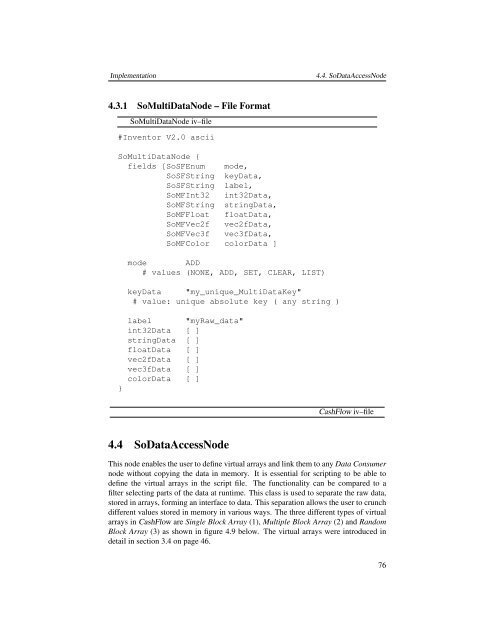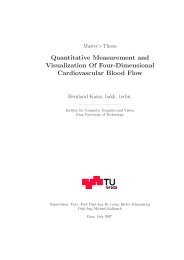CashFlow, A Visualization Framework for 3D Flow - Studierstube ...
CashFlow, A Visualization Framework for 3D Flow - Studierstube ...
CashFlow, A Visualization Framework for 3D Flow - Studierstube ...
- No tags were found...
You also want an ePaper? Increase the reach of your titles
YUMPU automatically turns print PDFs into web optimized ePapers that Google loves.
Implementation4.4. SoDataAccessNode4.3.1 SoMultiDataNode – File FormatSoMultiDataNode iv–file#Inventor V2.0 asciiSoMultiDataNode {fields [SoSFEnum mode,SoSFString keyData,SoSFString label,SoMFInt32 int32Data,SoMFString stringData,SoMFFloat floatData,SoMFVec2f vec2fData,SoMFVec3f vec3fData,SoMFColor colorData ]mode ADD# values (NONE, ADD, SET, CLEAR, LIST)keyData "my_unique_MultiDataKey"# value: unique absolute key ( any string )label "myRaw_data"int32Data [ ]stringData [ ]floatData [ ]vec2fData [ ]vec3fData [ ]colorData [ ]}<strong>Cash<strong>Flow</strong></strong> iv–file4.4 SoDataAccessNodeThis node enables the user to define virtual arrays and link them to any Data Consumernode without copying the data in memory. It is essential <strong>for</strong> scripting to be able todefine the virtual arrays in the script file. The functionality can be compared to afilter selecting parts of the data at runtime. This class is used to separate the raw data,stored in arrays, <strong>for</strong>ming an interface to data. This separation allows the user to crunchdifferent values stored in memory in various ways. The three different types of virtualarrays in <strong>Cash<strong>Flow</strong></strong> are Single Block Array (1), Multiple Block Array (2) and RandomBlock Array (3) as shown in figure 4.9 below. The virtual arrays were introduced indetail in section 3.4 on page 46.76





